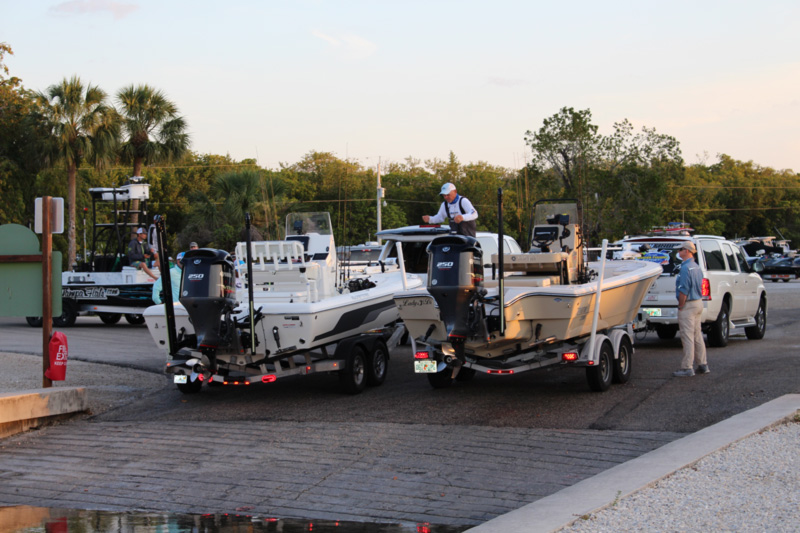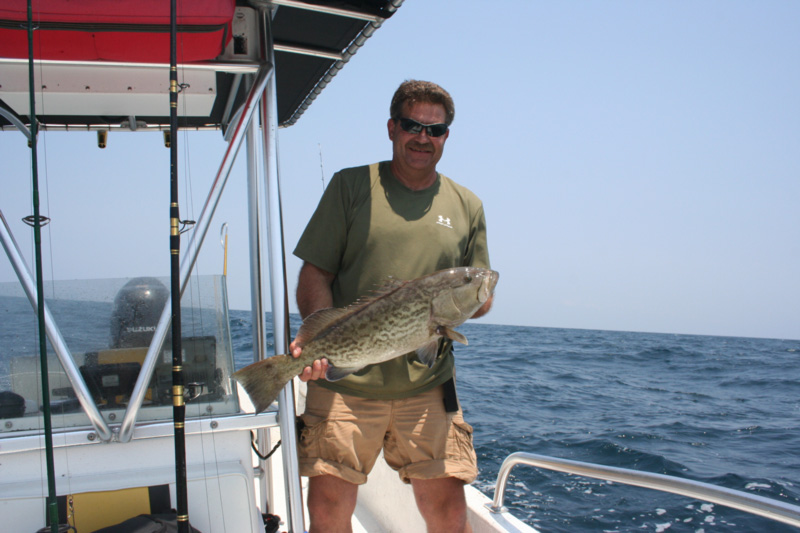Our caravan assembles in a K-Mart parking lot at 7 pm, for a final huddle before departing on the 10-hour trailer to Bogue Inlet in southern North Carolina. Our goal: to get four trailerboats to the inlet — in functional condition — by daybreak the next morning. Our plan: to slay numerous grouper, kingfish, snapper, and whatever the heck else we can sink a hook into during the next three days. It will be sunup to sunset fishing, with no breaks and no excuses. On the fourth morning, we’ll load up and make the long haul home. This is an ambitious road trip, and towing multiple boats for long distances almost guarantees that there will be a bump or two along the way. But we have a secret weapon: a pair of inveterate trailerboating professional-amateur grease monkeys, Scotty and Mike Hyers. It’s like having our own personal pit crew along for the ride, and they prove their mettle with a six-minute tire change when one of the trailer tires blows out at 65 mph on I-95.

We make it there in time to launch at sunrise and half an hour later the first catch of the trip, a barely keeper cobia, is flopping in my fishbox. Over the course of the next several days we catch enough fish to fire up the grill each and every evening, and then we hit the road with a winter supply of multi-species dinners on ice. Eventually, we arrive home with all four rigs intact and some seriously hard-core fishing stories. You want to get into a fishing adventure like this? Then you’ll need the trailering know-how to make it happen. Use these five tips — but don’t make these five blunders — and your trip should be a good one.
Trailering Tips
- TEAM EFFORT – Make runs like this as a group so there’s help at hand if anything goes wrong. Every vehicle should carry at least two drivers so you can take shifts. Driving to the point of exhaustion is a major reason why accidents occur, and accidents shut down fishing trips just as effectively as a 50-knot wind.
- SPARE PARTS – As Scotty showed me on this trip (a pilgrimage which took place multiple times without a trip-killing mishap), carrying spare parts in imperative. We’re not just talking about a spare tire. Prior to a major haul you need to make up a repair kit, which includes spare bearings (don’t forget the extra spindle nut, washer, and cotter pin), a spare wheel hub, spare lightbulbs, a spare tail light assembly, spare lug nuts, a spare sidelight assembly, spare wire plugs (male and female), and spare wire. If you’re as thorough as Scotty you’ll have a spare axle for your trailer, too. Naturally, you’ll also need a full tool kit that includes everything you’d need to make use of those spare parts. Scotty-like trailerboaters will also fill the back of their truck with items like floor jacks, an air compressor and air tools, chocks and blocks, and multiple grease guns.
- CHILL OUT – When you arrive at your destination you’ll be chomping at the bit to dunk the boat and start fishing. But take your time when you pull up to the ramp. You want at least 10 minutes to pass before you launch to allow your bearings and hubs to cool off. Back down into cool saltwater while they’re still hot from the road trip, and the metal might crack. Same goes for your lights. If they take a dunking while they’re still hot from the road trip the bulbs will pop, so allow plenty of cool-down time and unplug them before you back down the ramp.
- BREAK TIME – Take frequent breaks. Yes, this will delay your arrival and you’ll need to plan in additional travel time to make up for them. But there are several mechanical reasons to stop every three hours or so. First off, you’ll want to feel the hubs of each trailer wheel as soon as you pull over. If the bearings are sufficiently greased and in good shape, the hubs will be cool or slightly warm to the touch. If not, they’ll feel hot. If a hub is hot enough to make you jerk back your hand in pain, you’re danger-close to a bearing failure. Secondly, the breaks give you an opportunity to check your lights and make sure they’re all working properly. As we all know, faulty lights can lead to flashing lights in the rear-view, which can lead to a significant delay-of-fishing penalty.
- RUNNING ON EMPTY – Generally speaking, you’ll want to keep your load as light as possible to stress your trailer and tow vehicle as little as possible. One way to eliminate a huge amount of weight from the haul is to run your boat until it’s nearly out of fuel before loading up for the big road trip. Gasoline weighs about 6.2 pounds per gallon. If you’re pulling a boat that carries 100 gallons of fuel, that’s another 620 pounds of weight — a significant amount for any rig on the road. Also empty freshwater tanks and put weighty gear in your truck, not the boat.

Trailering Blunders
- DON’T KNOW JACK – If you end up having to jack up your rig to change a tire, in most cases you’ll want to place the jack under the frame at the U-bolt plate. However, in some cases, it’s possible to bend or damage the frame by jacking on it. Make this blunder and you’ll regret it as long as you own the rig. So, before you hit the road make sure you do some research and know the manufacturer’s recommended jacking point.
- BACK AND FORTH – It’s easy to accidentally back off the end of a boat ramp when you’re launching, especially at a ramp you haven’t used before or aren’t familiar with. When this happens, some people will put their truck into forward and try to pull the rig right back up. This is a major blunder which can cause major damage — think about the situation before you act. The weight of your boat is still bearing down on the trailer, pinning the wheels and/or axel against the end of the ramp. Before trying to pull back up you need to unload your boat, first. This will get all of the weight off of your trailer. Once the boat’s out of the way you can usually pull the trailer back over the edge quite easily.
- AIR HEADS – If you use air tools to put on your lug nuts, don’t hit the road until you check the nuts with a hand wrench. One of our guys didn’t do so on the Bogue trip, and this mistake resulted in a wheel flying off the trailer at 60 mph. Thank goodness it was a tandem-axel trailer, or the result could have been disastrous — worse yet, it could have caused a massive delay-of-fishing penalty. The cause? As it turned out, the compressor powering the air tools had blown a circuit breaker and no one had noticed. There was still enough air pressure in the tank to make it sound like those lug nuts were wound up tight, but they weren’t.
- BACKING BLUNDER – Remember, you pulled the plug on your trailer lights before launching the boat. If your trailer has surge brakes, make sure you don’t leave them unplugged when you try to back up any uphill inclination. Most surge brakes are disabled by the current from your tow vehicle’s reverse lights. If the plug isn’t in and you try to back up, the surge brakes will kick in and stop you in your tracks.
- SLAM DANCER – One of the most catastrophic blunders any trailerboater can make is to slam on the brakes. Of course, when you need to stop you need to stop. But always apply the brakes slowly, with increasing pressure, instead of slamming them down hard. Jamming on the brakes is how you jackknife the truck and trailer, an extremely dangerous event. This occurs when the trailer has so much momentum its rear end continues moving forward, faster than the tow vehicle. It then swings out to the side, pulling the rear of the truck sideways. The result? Usually, a severe accident occurs.
So there you have it: five do’s and five don’ts of trailering which you need to know before you hit the road. Start your planning, assemble your crew, and pick your fishing destination — it’s time for a fishing road trip you’ll remember for the rest of your life.